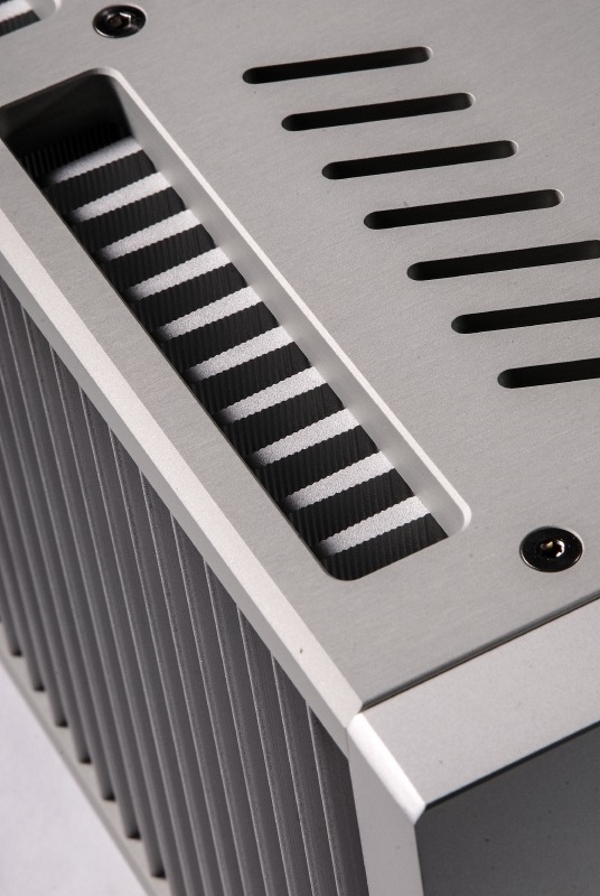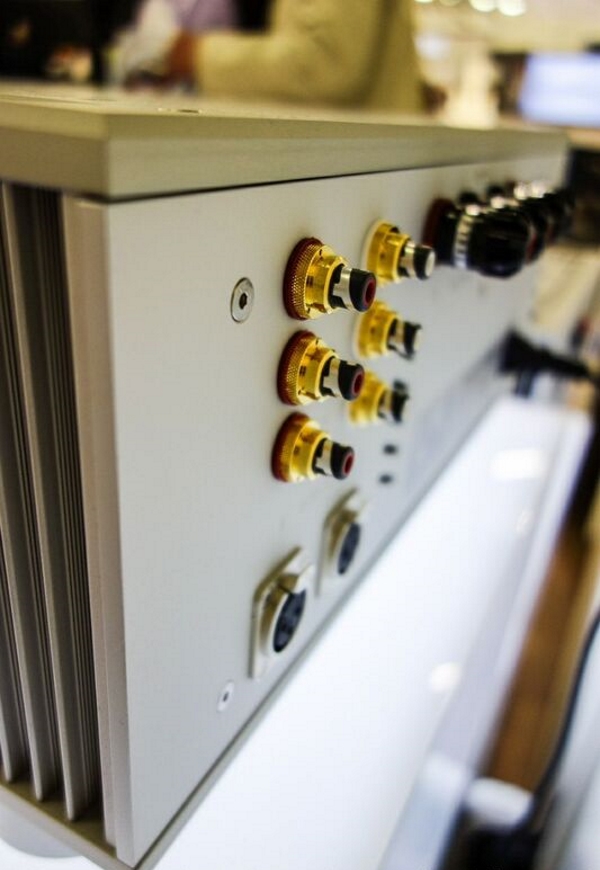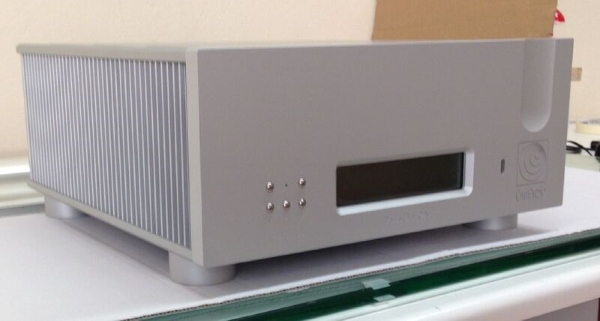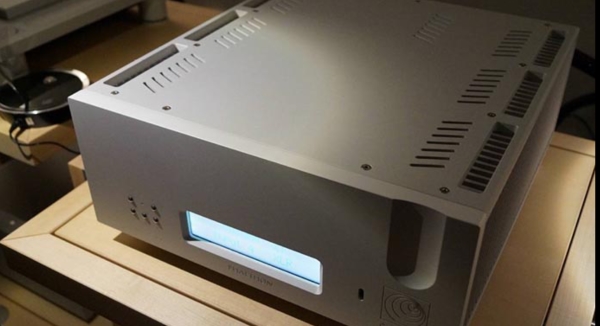
Not to be fooled by its elegant looks, the Phaethon has impressive driving power. Its performance with the Hansen Prince especially is surprising, given how complicated these speakers are, not the kind that can be driven by any amplifier. Obviously by driving, I do not mean creating sound -I mean playing and making sure every frequency is accounted for, that there is a strong bass performance, incredible speed and impressive dynamics. There is a strong power within this minimal and elegant case that surpasses itself. This is not all: on one hand, it gives exquisite detail over the stage and on the other, it leaves voids almost large enough for you to wander in, with no overlay from any instrument.
Listening to the Phaethon with three completely different speakers, its real capability became more obvious. The Canterbury plays close up microphone recordings near the front surface of the speakers, in fact bringing them forward slightly. It is actually possible to create different stage performances and different tonal balances with the Canterburys by moving them closer or apart, or toeing in our out slightly. Regardless, their performance does not place the music way behind the speakers. Even if the depth they provide is very close to reality, their stage actually elongates the sound inside the room (which I actually personally prefer). The Phaeton especially brings out this characteristic of the Canterbury. In orchestral recordings with close up microphone, the near-stage instruments on the right and left jump into the room, but the cymbals crash meters behind. The vocals are like statues in flesh. Even the most complicated trebles are not cluttered, the extending frequencies from the cymbals float in the air. Lower frequencies are as controlled as they go deep.

The Hansen Prince has a completely different performance and a stage that goes way back. Vocals that appear in the same level as the Canterbrys are about a meter or more behind and the instruments go deeper beyond that. The bass articulation is excellent, low frequencies rattle along perfectly (in fact, maybe slightly more than necessary). The Canterbury extends the lower frequencies towards the room, its blooming effect is strong. On the other hand, with the Hansen, all the lower frequencies are sharply where they need to be, but the blooming effect is weak. The trebles are crystal clear and dynamic.
The Raidho D3 has a world of its own. It is a low decibel design with quite steady impedance. Even if it is not as difficult as the Hansen Prince, it also is not for every amplifier to drive. Raidho D3 is no problem for Phaethon. The bass is so strong, difficult to contain in a 30 square meter room. They are extremely fast speakers, many amplifiers may not be equally fast and may muddle the sound, but I did not witness the slightest blurriness in even the most complicated passages. The vocals do not come as much to the surface as with the Tannoys, but they are not thrown back a lot either. The dimension extends forward and back. The stage is very wide and high (the Canterburys’ stage is also very wide, but in height, the Raidho seems a touch more successful; so much so that and I had to re position the Canterburys). Even in the lowest volume levels, the bass is where it should be and is heard in proportion. The trebles seemed a tad excessive and felt as if buzzing in my ears, but the pair I had been listening to were new speakers, not yet ‘burnt in’ and I do not want to make any misleading comments, so will not comment on high frequencies for now. As with the D3, ‘burn in’ period of ribbon tweeters are quite long, so would be better to listen again in a few months and comment then. When I listened to the same speakers in Munich High End, they did not give me that feeling.

I was able to make another interesting comparison: I also listened to the Raidho D3 with the PST-100 Mk.2-Aelius combination. To be fair, I did not observe a noticeable difference from the musicality point of view. Raidhos relaxed a bit more, which naturally affected the stage and detail positively. I would expect the Aelius to perform with bigger authority in a larger room. Backlavas had claimed in Athens for the Phaeton, “99% of the Aelius, with less power, with the same topology of pre stage as PSt-100 Mk.2”, he was not wrong at all. In fact, I could add that the Phaethon can be a better choice for high sensitivity speakers like the Canterburys.
The Phaethon laid bare all the characteristics of three speakers with completely different performances, with their virtues and sins. When I look back on what I have written, it felt like I reviewed the three different speakers rather than the Phaethon. This is actually positive, because the Phaethon is an integrated amplifier that does not have any audible character, is very dynamic, transparent in the true meaning of the word and one that performs without interfering with the music. Its controlled bass performance is of a quality that can set example to many amplifiers and it can go way deeper than its size may suggest. It is obvious that Demetris Backlavas, has not only toppled the accustomed audio trends but also the myth of Phaethon who could not control the wild horses of the sun chariot. The extraordinary staging ability, relaying the actual spaces between the instruments, bringing out the dynamic contrasts with an exciting authority, emotion and musicality that are customary to all Ypsilon products, also exist in Phaethon. Coming to the most important issue for me, in portraying the true timbres of instruments, I believe only a few products can challenge the Phaethon (and any other Ypsilon product that I have listened to so far).

Time for a few negatives: Firstly, there is need for a very good power cord. I have used Sablon Audio’s Corona Reserva for the majority of listening sessions in my home. I witnessed a striking difference when I listened to a different system with StageIII Kraken. Corona Reserva is a very good cable for its price but the Kraken is clearly a different animal. It is also priced accordingly, at more than four times that of the Reserva (on the other hand, probably related to the synergy created by the fact that the entire cabling at my home is Sablon Audio, I do not hear most of the weaknesses against Kraken with my own system). Phaeton needs 600 hours to ‘burn in’. The bright trebles and slightly strained lower frequencies may upset you during the first 50 hours, but after 200 hours, things start to fall in place and continue to get better thereafter. It is best to leave it in standby mode, it takes quite a bit of time to warm up and show its true performance. There is also the issue of price. It is in a price category which is quite high for a lot of people, but after having witnessed its performance it would be shame to call it expensive. The main issue is to do away with ‘pre-power’ prejudice. In fact, there is no reason why a well designed integrated amplifier should perform worse than a ‘pre-power’ combination. In addition, it also eliminates the interconnect effects and costs. But by far the most dangerous characteristic of the Phaethon is that it is addictive. In fact, all Ypsilon products pose this threat. If you do not have a ‘pre-power’ obsession and if you dream of owning an integrated amplifier one day which simply serves music with all of its frequencies and one which you will passionately love for many years to come, you should definitely listen to the Phaethon. And oh, if you are ready to face any weakness of your speakers.
The Phaethon is a star born by the skirts of the Acropolis of Athens. It is a component that reflects the light of music which brightens our spirit as it actually is, an artisan product which topples customary beliefs. One of the many products of Demetris Backlavas’s creative intelligence which transforms electronics into art.
PS: I am aware that I have written a rather technical review where I have not discussed music at all. Nevertheless, I did not want to miss this chance when I got the opportunity of listening to the same amplifier with different speakers. If I started discussing albums, it would be a very long article. I will make up for this in my article about the review of Ypsilon CD player.
Ahmet Kip
Ypsilon Phaethon
Output Power Before Clıppıng 110ms @ 8 Ohm 160ms @4 Ohm Bandwıdth 11hz -75Khz -3db Output Impedance 0,5ohm Input Impedance 47 Kohm Gaın X60 Inputs 3 Rca +1 Xlr Unbalanced Power Consumptıon 125w @ İdle Dımensıons 400x185x425 (W X H X D)Mm Weıght 35 Kgr
Price in Turkey: 18.000 Euro (Ex VAT)
Distributor: AudioAVM / www.audioavmhighend.com

Bir yorum ekleyin